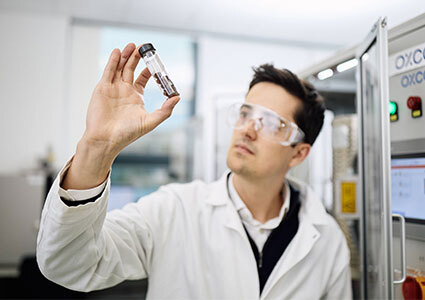New technology is unlocking the potential of sustainable aviation fuel
Regulatory frameworks are evolving in different regions to support the adoption of sustainable aviation fuel (SAF) as the aviation industry needs to reduce its carbon emissions. The EU’s ReFuelEU initiative is a notable example, mandating that 70 percent of the 2050 blending requirement be SAF, with 50 percent of that sourced from Power-to-Liquids (PtL). This initiative sets a precedent for other countries, including the UK, US, and beyond, to follow suit with their own mandates and mechanisms. Most recently Singapore’s decision to use SAF to power all departing flights from 2026 demonstrates the rapid progression of SAF into mainstream aviation operations. Hence whilst SAF is a very small proportion of jet fuel today, it has huge potential growth prospects. Ultimately there is broad support behind the prize, enabling a future where people can fly with limited concerns about their impact on climate change.
Currently, most sustainable aviation fuel is derived from vegetable oil, commonly known as ‘HVO’ fuel, using the HEFA process. This is largely because it’s the easiest. The vegetable oil molecules are fairly close to jet fuel, already being long chains of carbon and hydrogen with little oxygen or other contaminants. First the small amount of oxygen is removed, and then the hydrocarbon chains are saturated, isomerized, and cut to the right lengths for jet fuel.
However, growing concerns about land use and scalability are prompting a diversification of feedstocks. Even with some demand destruction for flying, the demand for SAF is huge and it is now widely accepted that HEFA fuel alone cannot be scaled to the levels required because of the competition with food and biodiversity. Alternative production processes are emerging, which use various sources of carbon-based waste, often called second-generation biofuels or waste-based fuels. The complexity and variability of these waste streams and the difficulties in aggregating and converting them to jet fuel means they have both technology and feedstock challenges. Given this, there is growing excitement in processes which use CO2 and green hydrogen as the feedstock, so called e-fuels or Power to Liquids (PtL).
 In using CO2 as the feedstock along with green hydrogen from renewable energy, e-fuels or Power-to-Liquids (PtL) have the potential for scale with minimal impact on land use. The core challenge for e-fuels currently is cost. First, the green hydrogen cost is key, and this depends on the green electricity price, as well as the cost of reliable low-cost electrolysers. The good news is both these are reducing as the industry scales. Second, you need low-cost pure CO2. If the CO2 is biogenic or captured from the air (DAC) the process is circular, but in the short to medium term fossil or mineral CO2 can also be used. Using fossil or mineral CO2 in the process is not circular, but it means getting two uses out of some of the carbon that was dug up before it ends up in the atmosphere and still reduces emissions significantly. The good news is the CO2 capture industry is increasingly mature and low-cost, and pure captured CO2 sources are becoming more common. Finally, there is growing understanding of the conversion to fuel and how this is far simpler than most expect.
In using CO2 as the feedstock along with green hydrogen from renewable energy, e-fuels or Power-to-Liquids (PtL) have the potential for scale with minimal impact on land use. The core challenge for e-fuels currently is cost. First, the green hydrogen cost is key, and this depends on the green electricity price, as well as the cost of reliable low-cost electrolysers. The good news is both these are reducing as the industry scales. Second, you need low-cost pure CO2. If the CO2 is biogenic or captured from the air (DAC) the process is circular, but in the short to medium term fossil or mineral CO2 can also be used. Using fossil or mineral CO2 in the process is not circular, but it means getting two uses out of some of the carbon that was dug up before it ends up in the atmosphere and still reduces emissions significantly. The good news is the CO2 capture industry is increasingly mature and low-cost, and pure captured CO2 sources are becoming more common. Finally, there is growing understanding of the conversion to fuel and how this is far simpler than most expect.
This is what we are focused on at OXCCU through our simplified, one-step process that converts CO2 and H2 into SAF. We have shown that it’s possible to make jet fuel-range hydrocarbons in a single step with high conversion and selectivity. Modelling completed by independent researchers from Imperial College London, through Imperial Consultants, has shown that OXCCU’s one-step process significantly reduces operational costs due to higher selectivity yield in the jet fuel range, has a 50 percent lower capital cost and has a reduced environmental impact.
With theoretically unlimited feedstocks of CO2 and H2, PtL technology has the potential to revolutionize the SAF market, providing a scalable alternative that addresses the setbacks of biofuels. CO2 is a widely available feedstock which we can be confident of having in the future and which we know how to clean, compress and transport safely. Green hydrogen is rapidly emerging as electrolyser technology scales, renewables continue to scale, and grids become greener, and we are seeing costs decrease.
As the demand for sustainable aviation fuel (SAF) grows, the landscape is evolving rapidly, presenting huge opportunities. Global mandates such as ReFuelEU and Singapore’s recent SAF levy demonstrate the rapid integration of SAF into mainstream aviation operations. Alongside expanding Power-to-Liquids (PtL) technology, SAF mandates and revenue certainty mechanisms, key components such as sites for SAF production plants with available feedstock, a robust supply chain, and access to engineering talent are crucial for achieving widespread adoption.
By Andrew Symes
For a list of the sources used in this article, please contact the editor.
Andrew Symes is CEO at OXCCU. OXCCU’s sustainable aviation fuel (SAF), called OXEFUEL, is created by combining captured carbon dioxide and renewably sourced green hydrogen using a novel iron-based catalyst. This innovative process results in a more cost-effective and decarbonized alternative to fossil-based Jet A fuel for commercial air travel.
